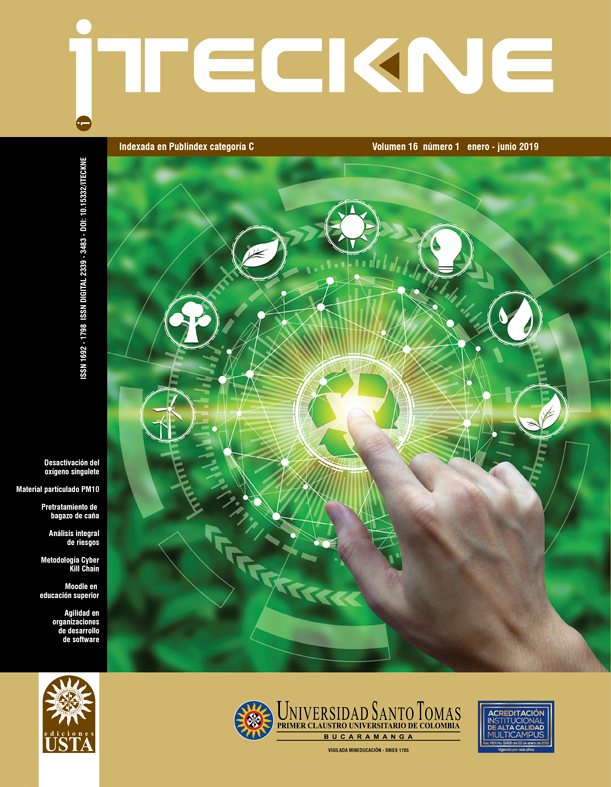Quenching of singlet oxygen by extract of peels of the fruit of syzygium cumini
Abstract
Recent research has shown the importance of plant extracts as powerful antioxidants owing to the presence of chemically active components such as polyphenols, anthocyanins, flavonoids, among others. This synergy of the components becomes a possible alternative to the use of antioxidants of synthetic origin. In this study, Syzygium cumini fruit peel was used to determine the antioxidant activity against singlet oxygen. The extract showed appreciable amounts of phenolic groups (about 8.55 AGE mg/g fruit weight). HPLC-DAD characterization showed at least 3 anthocyanins of higher relative abundance (malvidin 3,5-diglucoside, delphinidin 3,5-diglucoside and petunidin 3,5-diglucoside). The percentage of quenching of singlet oxygen was determined at different concentrations of the ethanolic extract, finding a value of 60% at a concentration of 0.39 mg/mL.
Downloads
References
[2] J.N. Moloney, T.G. Cotter, “ROS signalling in the biology of cancer,” Semin Cell Dev Biol, vol. 80, pp. 50-64, 2018.
[3] C.E. Díaz-Uribe, F. Martínez, W. Vallejo, “Synthesis and characterization of TiO2 thin films doped with copper to be used in photocatalysis,” Iteckne, vol. 10, pp. 16-20, 2013.
[4] F. Galli, M. Piroddi, C. Annetti, C. Aisa, E. Floridi, A. Floridi, “Oxidative stress and reactive oxygen species,” Contrib Nephrol, vol. 149, pp. 240-260, 2005.
[5] M.Y. Jung, J.H. Lee, “Direct spectroscopic observation of singlet oxygen quenching and kinetic studies of physical and chemical singlet oxygen quenching rate constants of synthetic antioxidants (BHA, BHT, and TBHQ) in methanol,” J Food Sci. vol.;75(6), pp. C506-513, 2010.
[6] N.F. Ito, “Carcinogenicity and modification of the carcinogenic response by BHA, BHT, and other antioxidants,” CRC Cr. Rev Toxicol, vol. 15(2), pp. 109-150, 1985.
[7] V. Unsal, E. Belge-Kurutas, “Experimental Hepatic Carcinogenesis: Oxidative Stress and Natural Antioxidants,” J Med Sci, vol 12, pp. 686-691, 2017.
[8] R.S. Birur, R.S. Iyer, S.R. Subbaramaiah, S.A. Richard, B.l. Dhananjaya, “Antioxidant activity of Syzygium cumini leaf gall extracts,” Bioimpacts. vol 4(2), pp. 101-107, 2014.
[9] J.M. Aubry, “Search for singlet oxygen in the decomposition of hydrogen peroxide by mineral compounds in aqueous solutions,” J. Am. Chem. Soc. vol 107, pp. 5844-5849, 1985.
[10] C.E. Díaz-Uribe, M. Daza, F. Martínez, “Oxidation of anthracene with singlet oxigen generated chemically by the sodium molibdate/hydrogen peroxide system,” Rev. Col. Quim vol 37(1), pp. 45-53, 2008.
[11] K. KjellTorskangerpoll, O.M. Andersen, “Colour stability of anthocyanins in aqueous solutions at various pH values,” Food Chem., vol 89, 99 427-440, 2005.
[12] L.M. Zapata, A.M. Heredia, C.F. Quinteros, A.D. Malleret, G. Clemente, J.A, “Cárcel Optimización de la extracción de antocianinas de arándanos,” Cienc. Docen Tecn. vol. pp. 1851-1716, 2014.
[13] Da-Silva, R., I. Hermosín Gutiérrez, M. I., De Carvalho Tavares, A., Mota Ramos, S., Gómez Alonso, E. García Romero, “Comprehensive study of the phenolic composition of the edible parts of jambolan fruit (Syzygium cumini (L.) Skeels,” Food Research International, 82, 1-13. 2016.
[14] V. Nardello, M.J. Marti, C. Pierlot J.M Aubry, “Photochemistry without light: oxidation of rubrene in a microemulsion with a chemical source of singlet molecular oxygen (1O2, 1Δg),” J. Chem. Edu. Vol. 76, 1999, 1285-1288.



















